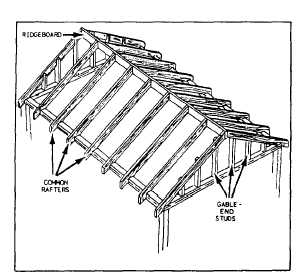Let’s take an example. Suppose you want to figure
the board measure of a piece of lumber 10 feet long by
10 inches wide by 1 inch thick. Scan down the column
(fig. 2-12, view B) headed by the 12-inch graduation to
10, and then go horizontally to the left to the figure
directly below the 10-inch graduation. You will find the
figure to be 84, or 8 4/12 board feet. For easier
calculating purposes, you can convert 8 4/12 to a
decimal (8.33).
To calculate the cost of this piece of lumber,
multiply the cost per board foot by the total number of
board feet. For example, a 1 by 10 costs
||content||
.15 per board
foot. Multiply the cost per board foot (
||content||
. 15) by the
number of board feet (8.33). This calculation is as
follows:
What do you do if the piece is more than 1 inch
thick? All you have to do is multiply the result obtained
for a 1-inch-thick piece by the actual thickness of the
piece in inches. For example, if the board described in
the preceding paragraph were 5 inches thick instead of
1 inch thick, you would follow the procedure described
and then multiply the result by 5.
The board measure scale can be read only for
lumber from 8 to 15 feet in length. If your piece is longer
than 15 feet, you can proceed in one of two ways. If the
length of the piece is evenly divisible by one of the
lengths in the table, you can read for that length and
multiply the result by the number required to equal the
piece you are figuring. Suppose you want to find the
number of board feet in a piece 33 feet long by 7 inches
wide by 1 inch thick. Since 33 is evenly divisible by 11,
scan down the 12-inch column to 11 and then go left to
the 7-inch column. The figure given there (which is
65/12, or 6.42 bd. ft.) is one-third of the total board feet.
The total number of board feet is 6 5/12 (or 6.42) x 3,
or 19 3/12 (or 19.26) board feet.
If the length of the piece is not evenly divisible by
one of the tabulated lengths, you can divide it into two
tabulated lengths, read the table for these two, and add
the results together. For example, suppose you want to
find the board measure of a piece 25 feet long by
10 inches wide by 1 inch thick. This length can be
divided into 10 feet and 15 feet. The table shows that the
10-foot length contains 8 4/12 (8.33) board feet and the
15-foot length contains 12 6/12 (12.5) board feet. The
total length then contains 8 4/12 (8.33) plus 12 6/12
(12.5), or 20 10/12 (20.83) board feet.
Figure 2-13.—Framework of a gable roof.
Figure 2-14.—Typical common rafter with an overhang.
DESIGNS
LEARNING OBJECTIVE: Upon completing
this section, you should be able to describe
procedures for the layout and installation of
members of gable, hip, intersecting, and shed
roof designs.
As we noted earlier, the four most common roof
designs you will encounter as a Builder are gable, hip,
intersecting, and shed. In this section, we will examine
2-10





